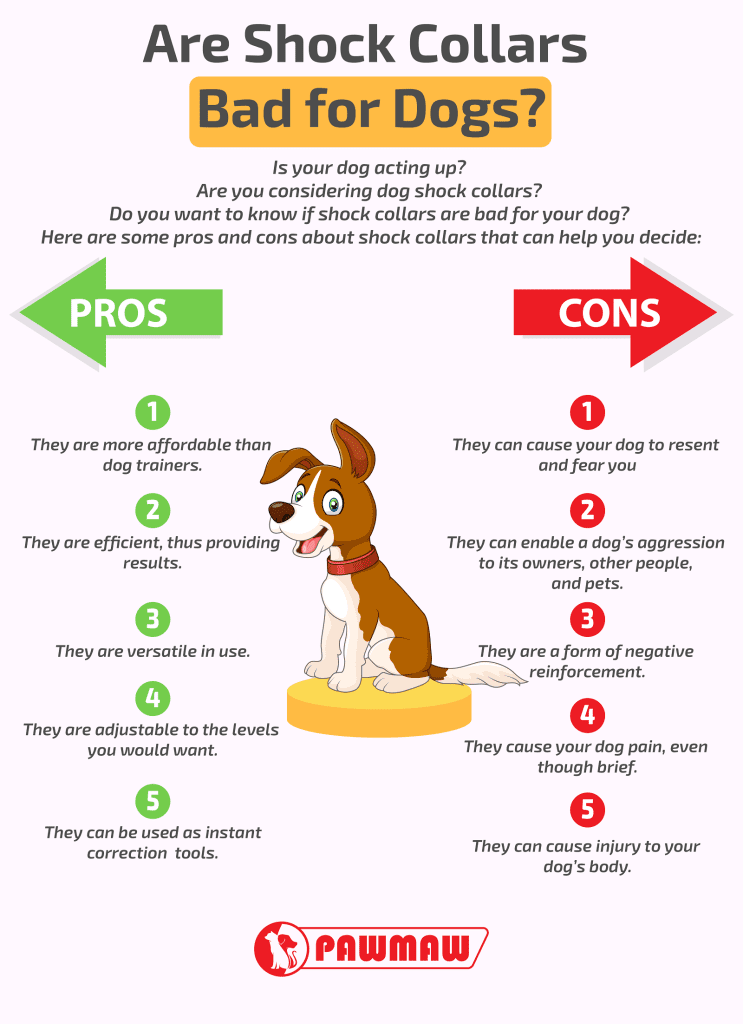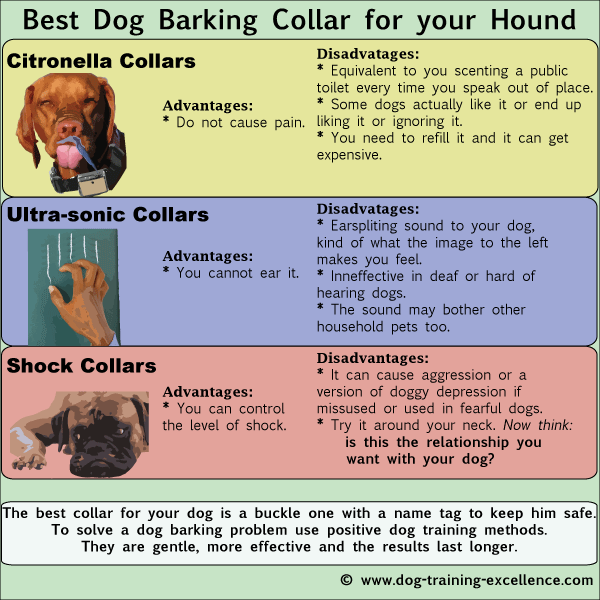If you’re wondering about the advantages and disadvantages of using a bark collar for your beloved canine companion, you’re in the right place.
Whether you’re tired of constant barking or seeking a solution to keep your pup’s noise levels in check, weighing the pros and cons before deciding is essential.
In this article, we’ll explore the benefits and drawbacks of utilizing a bark collar, helping you make an informed choice that prioritizes your dog’s well-being and peace of mind.
Pros of Using a Bark Collar
Effective in Controlling Barking
A bark collar can be an effective tool in controlling excessive barking in dogs. It uses different methods to interrupt barking, such as sound, vibration, or static stimulation. When used correctly, it can help teach your dog to associate their barking with an unpleasant sensation, encouraging them to reduce their barking frequency.
Suitable for Training Purposes
Bark collars can serve as a valuable training aid, especially for dogs who struggle with excessive barking. With consistent use, they can help your dog learn that barking excessively is not desirable behavior. By providing an immediate consequence for barking, it helps reinforce the idea of quietness and discourage unnecessary noise.
Convenient and Low-maintenance
Using a bark collar allows a convenient way to address your dog’s excessive barking. Once properly fitted, it requires minimal effort from you. Unlike other methods that may require your constant presence or attention, a bark collar can be left on your dog while you go about your daily activities. Additionally, most bark collars are lightweight, comfortable for your dog, and require little maintenance.
Provides Consistent Correction
One of the advantages of using a bark collar is its ability to provide consistent correction. Unlike verbal cues or shifting attention, which may vary depending on your mood or availability, a bark collar delivers the same consequence each time your dog barks excessively. This consistent feedback helps your dog understand the correlation between their barking and the resulting discomfort or stimulation.
Can Be Used as a Deterrent
Bark collars can also serve as a deterrent to prevent unwanted behaviors, such as excessive barking, especially in certain situations or environments. For example, if your dog tends to bark excessively when left alone or when encountering certain triggers, using a bark collar can discourage such behavior by associating it with an unpleasant consequence. This can be particularly helpful in preventing neighbor complaints or maintaining a peaceful household.
Cons of Using a Bark Collar
May Cause Discomfort or Pain
One of the potential downsides of using a bark collar is that it may cause discomfort or pain to your dog. Certain types of bark collars use static stimulation or prongs that deliver a mild electric shock. While these sensations are typically harmless, some dogs may find them distressing or painful. It’s important to closely observe your dog’s response and discontinue use if you notice signs of distress or discomfort.
Potential for Fear or Anxiety
The use of bark collars is not without the possibility of causing fear or anxiety in dogs. Some dogs may become fearful or anxious when they associate the stimulation from the collar with their barking. This can lead to a negative emotional response and may even worsen the barking behavior rather than reducing it. It’s crucial to carefully monitor your dog’s behavior and seek alternative methods if you notice increased fear or anxiety.
Limited Effectiveness in Some Cases
While bark collars can be effective for many dogs, they may not work as effectively for all individuals. Some dogs may be less responsive to the deterrent effect of the collar, or their barking may be driven by underlying medical or behavioral issues that require different approaches. It’s important to assess your dog’s needs and consult a professional to determine if a bark collar is the right solution for your canine companion.
May Not Address Underlying Causes
Bark collars primarily focus on suppressing the symptoms of excessive barking rather than addressing the underlying causes. Barking can be a form of communication, indicating fear, boredom, or distress. If these underlying issues are not addressed, your dog may find alternative ways to express discomfort or continue displaying problem behaviors. It’s essential to consider the root causes of your dog’s barking and address them alongside the use of a bark collar.
Potential for Negative Associations
There is a possibility that your dog may associate the discomfort caused by the bark collar with other unrelated stimuli or individuals. For example, if someone approaches your dog while wearing the collar and your dog receives a correction, they may misinterpret the association and develop fear or aggression towards that person. Awareness of these potential associations is crucial, and ensuring proper socialization and positive experiences while using a bark collar is crucial.
Effectiveness of Bark Collars
Different Types of Bark Collars
There are various types of bark collars available in the market, each utilizing different deterrence methods. Some common types include citronella spray collars, vibration collars, ultrasonic collars, and static stimulation collars. Understanding the differences and selecting the most appropriate type for your dog is essential for maximizing effectiveness and minimizing potential discomfort.
Factors Influencing Effectiveness
Several factors can influence the effectiveness of a bark collar, including the breed and temperament of your dog. Some breeds may require different levels of stimulation, while certain temperaments may respond better to specific deterrent methods. Additionally, consistency of use, proper fitting, and timely correction play a vital role in achieving the desired results. Identifying these factors and tailoring the use of a bark collar accordingly can enhance its effectiveness.
Adjustability and Sensitivity Levels
Many bark collars offer adjustable settings, allowing you to customize the level of stimulation or deterrence based on your dog’s response and needs. This feature is particularly beneficial as it enables you to find the most suitable and effective correction level without causing unnecessary discomfort. Gradually increasing or decreasing the sensitivity levels can fine-tune the collar to match your dog’s unique barking behavior.
Safety Concerns with Bark Collars
Risk of Physical Injury
There is a potential risk of physical injury when using bark collars, particularly those that utilize static stimulation or prongs. These collars can cause skin irritation, burns, or other injuries if not correctly fitted or used. It is crucial to carefully follow the manufacturer’s instructions on fitting and use to ensure the collar is safely secured and does not risk your dog’s physical well-being.
Potential for Skin Irritation
Some dogs may experience skin irritation or allergic reactions from the materials used in a bark collar. This can range from minor discomfort, such as redness or itching, to more severe reactions. It’s essential to regularly inspect your dog’s skin for any signs of irritation and discontinue use if you notice any adverse reactions. Additionally, choosing a bark collar with hypoallergenic materials can help reduce the risk of skin irritation.
Potential for Interference or Malfunction
Bark collars that rely on electronic components or batteries can be susceptible to interference or malfunction. Environmental factors such as electromagnetic interference or low battery levels may impact the collar’s effectiveness and deliver incorrect or inconsistent corrections. Regularly checking the batteries, ensuring secure connections, and providing proper maintenance can help minimize the risk of malfunction and ensure the collar operates as intended.
Alternative Methods to Bark Collars
Positive Reinforcement Training
Positive reinforcement training is an alternative method to address excessive barking in dogs. This training approach focuses on rewarding and reinforcing desirable behaviors, such as quietness, rather than punishing or suppressing unwanted behaviors. By using rewards such as treats, praise, or play, you can encourage your dog to remain calm and quiet, gradually reducing the frequency of excessive barking.
Environmental Modifications
Modifying the dog’s environment can also help reduce excessive barking. Identifying and addressing triggers that cause your dog to bark, such as loud noises or separation anxiety, can significantly impact their barking behavior. Creating a calm and stimulating environment, providing mental and physical exercise, and addressing potential anxiety triggers can contribute to a quieter and more contented dog.
Behavioral and Training Techniques
Implementing behavioral and training techniques can be an effective way to address excessive barking. Techniques such as desensitization and counterconditioning can help your dog become more comfortable and less reactive to specific stimuli that trigger barking. Seeking the guidance and expertise of a professional dog trainer or behaviorist can ensure you implement the most suitable techniques for your dog’s specific needs.
Considerations Before Using a Bark Collar
Dog’s Temperament and Sensitivity
Before using a bark collar, it’s crucial to consider your dog’s temperament and sensitivity. Some dogs may be more sensitive or reactive to corrective stimuli, while others may be more resilient. Assessing your dog’s personality and understanding their unique needs and responses can help determine if a bark collar is a suitable option or if alternative methods should be considered.
Overall Health and Age of the Dog
Your dog’s overall health and age should be considered before using a bark collar. Dogs with pre-existing health conditions, such as heart problems or anxiety disorders, may be more vulnerable to the stress associated with the collar’s corrective stimuli. Additionally, puppies or senior dogs may require different approaches as their physical and emotional needs differ from adult dogs.
Consulting with a Professional
Consulting with a professional, such as a veterinarian or a certified dog trainer, is highly recommended before using a bark collar. They can assess your dog’s specific needs, tailor the training approach accordingly, and provide guidance on the safe and effective use of a bark collar.
A professional’s expertise can help ensure your dog’s well-being and maximize the chances of achieving the desired results.
Proper Usage of Bark Collars
Following Manufacturer’s Instructions
To ensure a bark collar’s safe and effective use, it is essential to follow the manufacturer’s instructions carefully. This includes appropriately fitting the collar, adjusting the sensitivity levels, and using the collar only as intended. Familiarize yourself with the features and operation of the collar to avoid any misuse or potential harm to your dog.
Training and Acclimation Period
Allowing for a training and acclimation period is crucial when introducing a bark collar to your dog. Gradually introduce the collar, starting with shorter and supervised sessions and observing your dog’s response.
Combine the collar with positive reinforcement techniques to create a positive association and promote understanding. Consistency and patience are key during this period to help your dog adjust to the collar and its purpose.
Monitoring and Regular Breaks
Regularly monitor your dog’s behavior and response to the bark collar. Observe any signs of discomfort, stress, or negative associations.
It’s essential to provide regular breaks throughout the day when the collar is not in use to allow your dog some relief and prevent any potential adverse effects. Monitoring your dog’s well-being and adjusting the usage as needed will ensure their safety and comfort.
Conclusion
Using a bark collar can offer several benefits in controlling excessive barking and aiding in training efforts. However, weighing the pros and cons and considering alternative methods before deciding to use a bark collar is essential.
Your dog’s well-being, temperament, and specific needs should be the primary factors guiding your decision. Whether you use a bark collar or explore alternative approaches, always prioritize your dog’s comfort, safety, and overall happiness.
Seek professional guidance to ensure you make an informed and responsible choice that results in a harmonious relationship between you and your furry friend.













































